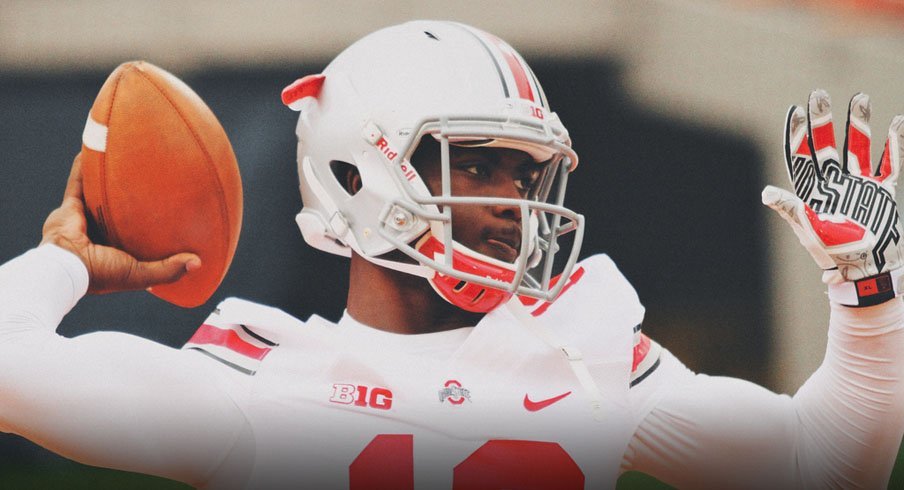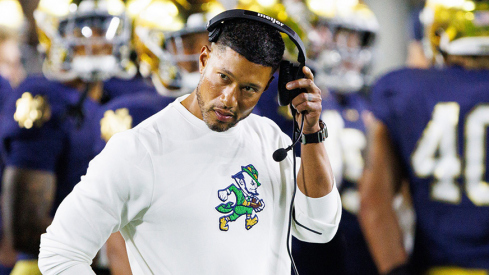After a dream three-game stretch that saw the underdog Buckeyes defeat Wisconsin, Alabama, and Oregon on the way to a national championship, expectations for the Ohio State offense were sky-high entering the season.
With the emergence of quarterback Cardale Jones after J.T. Barrett’s season-ending injury in OSU’s season finale against Michigan and an offense that peaked at exactly the right time, the Buckeyes entered the 2015 season as favorites to repeat as the last man standing in January. Star running back Ezekiel Elliott, the quarterback triumvirate of Cardale Jones, J.T. Barrett, and Braxton Miller, and four of five returning starters on the offensive line created a sense of excitement and greed. Just how many points could this Buckeye squad put up per game? Who outside the Big Ten had the offensive fire-power to keep pace?
Oho State’s embarrassment of riches continued as Braxton Miller announced his move to the H-back position, putting the nation’s most dynamic player in the wide receiver mix with returning contributors Jalin Marshall, Michael Thomas, and Dontre Wilson. With only the question of which quarterback would take the reins of a potent unit to be answered after a spirited spring/fall practice competition, all signs pointed towards an offensive juggernaut primed to take the college football nation by storm.
When Cardale Jones was named starting quarterback just before the season-opening Virginia Tech game, many expected the Bucks to stick with the offensive philosophy that won them the three most important games of the 2014 season, a multi-pronged attack that featured gap and zone-based runs with a healthy dose of vertical play action.
The multi-faceted OSU run game featured several concepts, but three plays defined the potent rushing attack coming into this season: the tight zone, sweep read, and counter trey.
Any conversation about the Ohio State run game starts with tight zone, an Urban Meyer staple from his first heading coaching job at Bowling Green.

Although the Buckeye offense showed less of the concept after J.T. Barrett’s season-ending injury, tight zone remained the offense’s bread-an-butter run play. In a 59-0 thrashing of Wisconsin in the Big Ten Championship game, Ezekiel Elliot continuously gashed the Badger defense with the concept, including an 81-yard scamper to put the Buckeyes up 14-0 (with the help of a great arc block by the tight end).

As opposing defenses adjusted to the tight zone’s success by clogging the interior A and B-gaps the play is designed to hit, Urban Meyer and offensive coordinator Tom Herman countered to attack the perimeter using the sweep read.

The sweep read marries the best of zone and gap-blocking schemes, utilizing pulling offensive linemen and down blocking like the staple bash, while also reading off the EMLOS (End Man on Line of Scrimmage) like tight zone.

Deep in the fourth quarter of the Sugar Bowl against the Alabama Crimson Tide, Ezekiel Elliott scored what could have arguably been the most important touchdown of the 2014 season off the sweep read. Elliott (with the help of beautiful downfield blocking by the offensive line and a great crack back block by wide receiver Evan Spencer) took the play 85 yards to the house, putting the Buckeyes up by 14 points in a 42-35 victory.

Meyer and Herman continued to attack the perimeter with what might have been the signature run concept of the 2014 season, the counter trey.

During the second half, of the inaugural College Football National Championship game, Herman attacked Oregon’s inability to stop the play, resulting in several chunk gains by Elliot.
Oregon’s odd front was particularly vulnerable to the play, as OSU constantly created a numbers advantage at the line of scrimmage to gash the defense for long gains. Up 21-20 in the third quarter, the OSU offense ran the play at will on a 75-yard drive that culminated with an Elliott eight-yard touchdown.

Ohio State’s running attack created numerous opportunities to challenge downfield coverage off a variety of vertical concepts. The threat of a quarterback run out of an empty look created a 48-yard hook up between Cardale Jones and current New York Jet Devin Smith to put the Bucks up by 24 points in the Big Ten Championship game.

The pulling guard and quarterback head nod (both actions false key the defense) and clever route design created a single coverage matchup for Devin Smith. The speedy receiver did the rest displaying the great route running (notice how he fakes to the post at the 30 yard line) and ball skills Buckeye fans came to expect from the eventual second round draft pick.
Unfortunately for Ohio State, expectation did not meet reality for a large part of the 2015 season.
After several well-documented games of inefficient quarterback play, lack of chunk plays through the air, questionable play calling, and a running game lacking an identity, Urban Meyer raised Buckeye Nation’s collective eyebrows by employing a dual system that featured J.T. Barrett as the red zone quarterback.
Things couldn’t have gone better.
As Kyle Jones stated in his breakdown of the OSU-Maryland game, “With Barrett in the game, the defense can't depend on Elliott acting as the primary ball-carrier, allowing OSU to use formation and motion to gain a blocking advantage at the point of attack.”
Barrett’s exceptional ability to make the correct read in the option game creates a conundrum for defenders as they are forced to choose between the lesser of two evils – Elliott or Barrett – in the red zone. The Maryland defense focused on Elliott, allowing Barrett to run wild to the tune of three touchdowns, including an early touchdown off quarterback split zone.

Running out of an empty formation Barrett was able to find the end zone off a designed quarterback run, another staple of the late-season 2014 offense.

Against Penn State Barrett again demonstrated his ability to rebalance numbers at the point of attack by making correct decisions in the read run game.
The first of Barrett’s two rushing touchdowns came off a variant of inside zone known as midline option. Instead of reading the EMLOS for the give or keep key, the read man became an interior defender (in this case right defensive end Curtis Cothran). Because Cothran (No. 52) squeezed the mesh between the quarterback and running back, Barrett make the easy keep read and takes the ball in for six with the help of an excellent block by tight end Marcus Baugh (No. 85) on Penn State linebacker Brandon Bell (No. 11).

Later in the game Barrett again made the correct read, this time giving to Elliott on tight zone as the read man (right defensive end Garrett Sickles), slow played the quarterback keep. Elliott did the rest, bouncing the play outside and running through two defenders on his way to the end zone.

After two strong performances, Barrett simply couldn’t be left off the field, leading Urban Meyer to name him the starter going into the week 8 Ohio State-Rutgers matchup. Barrett rewarded his head coach’s vote of confidence with a five touchdown effort, including a play action 30-yard touchdown toss to converted wide receiver Curtis Samuel. Due to Barrett and Elliott’s efficiency in the run game, the Scarlet Knights' weak safety was forced to honor the play action, slowing his run/pass key read and allowing Samuel to beat him vertically for his third touchdown of the season.

With a confident Barrett running an offense that has seemingly found an identity, where does the unit go from here? Looking back at Barrett’s 2014 late-season performance may likely tell the story, but which J.T. should we expect?
Against Indiana Barrett threw for 302 yards and four touchdowns, including a well-designed smash-post combo to Jalin Marshall.

Barrett followed up his Indiana performance with a strong run game showing against Michigan, racking up 89 yards and two touchdowns before leaving with a season-ending injury.

All signs point towards a late-season peak (sound familiar?), but serious challenges remain. With home games against Minnesota and an undefeated Michigan State squad, as well as a trip up north Thanksgiving weekend, will the J.T. Barrett-lead offense continue to surge facing three tough Big Ten defenses? If the Bucks finish to 2014 is any indication, the answer is a resounding yes.
Looking back at Barrett’s performance against Rutgers, imagine the possibilities if the offense gets the best of both J.T.’s: The dangerous runner that consistently makes correct give/keep reads AND the passer that confidently attacks the edges and takes targeted vertical shots off play action.
With Urban Meyer determined to continue working Braxton Miller and Curtis Samuel into the offense, will forced touches derail the momentum the offense has found under Barrett's steady hand and leadership? How will teams adjust to the threat Barrett brings to the run game? Will a wide receiver finally step forward to become the vertical threat play action threat that must be accounted for much like Devin Smith?
The month of November will tell the story. Buckle up Buckeye fans; this is going to be a fun ride.


